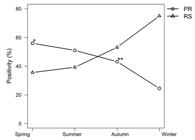Abstract
In South America, fascioliasis caused by the trematode Fasciola hepatica is an anthropozoonosis disease associated with significant economic losses and poor animal welfare. The objective of this study was to determine the prevalence of F. hepatica in the liver of buffaloes slaughtered from 2003 to 2017 in Brazil, and to perform a forecast analysis of the disease for the next five years using the Autoregressive Integrated Moving Average (ARIMA) model. Data analysis revealed an incidence of 7,187 cases out of 226,561 individuals. The disease presented a considerable interannual variation (p<0.005). Fasciola hepatica was more prevalent in the southern states of Brazil; Paraná, Rio Grande do Sul, and Santa Catarina, presenting 11.9, 7.7, and 3.2% of infected livers, respectively. The high frequency of liver condemnation in Paraná was influenced by weather conditions. The ARIMA models calculated a constant trend of the disease, depicting an average of its future prevalence. The models also described a worse-case and a positive-case scenario, calculating the effects of intervention measurements. In reality, there is an urgent need for regular diagnostic in the animals (fecal and immune diagnose) and in the environment (intermediate host), in order to avoid the high rates of infection.
Keywords:
Fasciola hepatica; trematoda; ruminants; epidemiology

 Thumbnail
Thumbnail
 Thumbnail
Thumbnail
 Thumbnail
Thumbnail
 Thumbnail
Thumbnail



